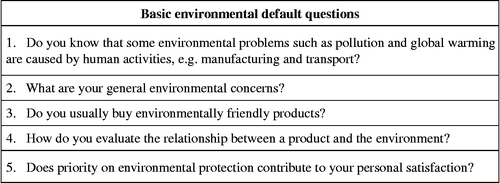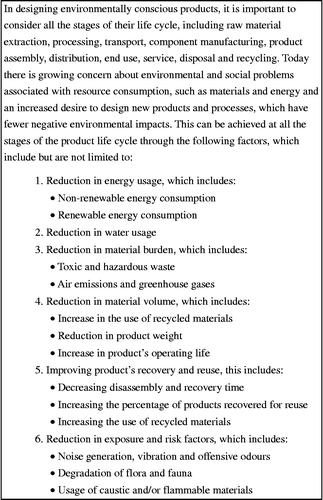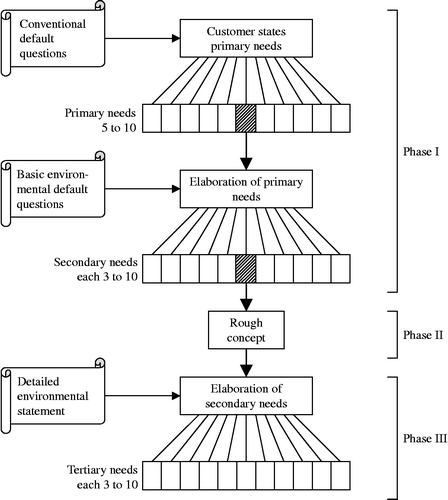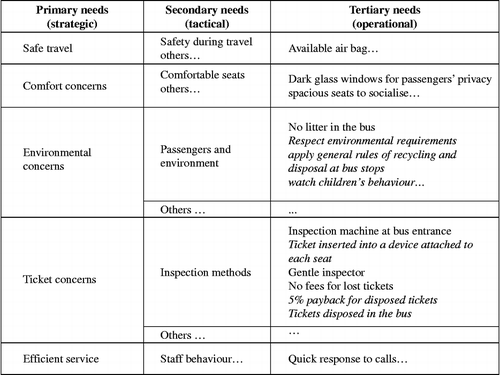Abstract
Environmentally conscious product development, eco-design or design for environment is the methodology trying to introduce environmental requirements into product design. The first step of this process is the gathering of customer requirements for a structured product development procedure, such as quality function deployment (QFD). The problem is that environmental requirements are usually unspoken by the customers. This paper describes a methodology for uncovering such requirements by using environmental default questions in an elaboration process. This leads to an increased customer environmental awareness, and it generates a comprehensive list of requirements suitable for use in a subsequent QFD process. The effects of the elaboration process are demonstrated in one case study.
1. Introduction
Quality function deployment (QFD) has been used worldwide since 1966 by organisations to bring products and services to market faster, better and cheaper. The success of a QFD analysis is largely based on the quality of the input information, namely the customer requirements. In addition, the traditional QFD process mainly captures the spoken requirements of the customers, which presents a problem for capturing environmental and non-environmental unspoken customer requirements.
The aim of this paper was to introduce environmental requirements into the traditional QFD process. In order to achieve this goal, environmental requirements have to be treated in exactly the same way as any of the other customer requirements. Consequently, the research is focused on the very early stages of the QFD process, namely the gathering of the voice of the customer (VOC) and the analysis and evaluation of the requirements, by introducing environmental awareness and assessment in these stages.
In order to uncover unspoken requirements, the customers as well as the product development team need some guidance through the VOC process. The proposed elaboration process provides this guidance.
2. The concept of the elaboration process
Urban and Hauser (Citation1993) said that the fundamental principle of QFD is to determine directly from the customers what they would like a particular product or service to do. Kott and Peasant (Citation1995) argued that the risk of misunderstanding and wrong translation of customer needs is caused by the nature of the input information, which is broad, mostly vague and difficult to interpret. In effect, no one can understand and explain customers' needs better than the customers themselves. Stickel and Bosserman (Citation1996) have proposed that to avoid risks in product development, designers need clearer input information and more specific ideas from the customers, which represent their satisfaction. This is an indirect customer contribution into product design. The concept of elaboration aimed at getting many ideas from the customers, describing a specific need. The designers consider customers as referees. This process changes customers' needs to be objective rather than subjective statements of the benefits, which a customer seeks from a product.
Applied Marketing Science Inc., Citation2000, Why We Do What We Do, Questions and Answers about VOCALYST, Waltham, MA, USA, stated that traditionally, a marketing company is given the responsibility for defining customers' needs and product requirements by discussing with customers the main features that they expect from a product or a service. The customer's main task is to express all the requirements and desires by talking or writing. The process is not formal as no list of conventional default questions is provided to the customers. The process leads to a big bundle of mixed words, phrases and recordings. It is left to the marketing team to understand the requirements and to eliminate or duplicate similar phrases. This means that the marketing team will translate customer requirements into the language of their organisation. The risk is that a customer requirement may mean something different to the customer than it does to the company. Moreover, Swanson and Hauser (Citation1995) wrote that this usually leads to isolating engineering and other development personnel from the customer and prevents them from gaining the first understanding of customer needs. As a result, the customer's real needs become somewhat abstract to other development personnel.
A further problem in the traditional process of defining customer requirements is that the bundle of requirements is sent to the customers to be arranged into a structure of primary, secondary and tertiary or detailed attributes. Some requirements, paraphrased by the marketing team, could be strange to the customers and far away from their real desires. Furthermore, this process is very complicated and time consuming if the number of the requirements is very large.
Klein (Citation1990) declared that many researchers have addressed these problems and Mazur (Citation1997) presented several published methodologies, where the product development personnel is directly involved in interpreting customer needs. This may involve visiting or meeting with customers, observing customers using or maintaining products, participating in focus groups or rotating development personnel through marketing, sales or customer support functions (Daetz et al. Citation1995).
The common problems of these methodologies extracted from the literature are as follows:
| • | informality; | ||||
| • | requirements not gained from the customers; | ||||
| • | requirements omitted; | ||||
| • | requirements not sorted in a centralised, common repository; | ||||
| • | requirements not properly analysed and | ||||
| • | contradictory requirements. | ||||
Traditionally, the primary needs vary between 5 and 10 in number and they are broad and lack precise information. These are strategic needs. Many case studies based on the primary customer requirements failed to meet the desires and the benefits, which a customer expects from a product (Liner et al. Citation1994).
In order to avoid the risk of misunderstanding, in the new approach customer primary needs are elaborated and explained by the customers. We assume that each primary need is elaborated into several secondary needs in the order of 3–10 for each primary need. This guarantees good information and explanation about the meaning of each customer's primary need.
Furthermore, we assume that each secondary need is elaborated into several tertiary needs, also in the order of 3–10 for each secondary need. This is a very important step of the elaboration process. It is the final stage to listen to the VOCs. The customer has to concentrate and think precisely, not arbitrarily, about the real desires behind his words. The tertiary needs are detailed requirements.
3. The phases of the elaboration process
A cross-functional team with representatives from each department (marketing, management and engineering) runs the elaboration process. There is no unique or specific method for running the elaboration process. It can be achieved by visiting, meeting with customers, participating in focus groups, etc. However, in order to achieve a useful outcome, it is recommended to perform the elaboration process in three phases, which is described in the following. A comparison between the common approach and the elaboration process for gathering customer requirements is summarised in Figure , showing the different activities and their achievers.
Figure 1 Comparison of the common approach and the elaboration process for gathering customer requirements.
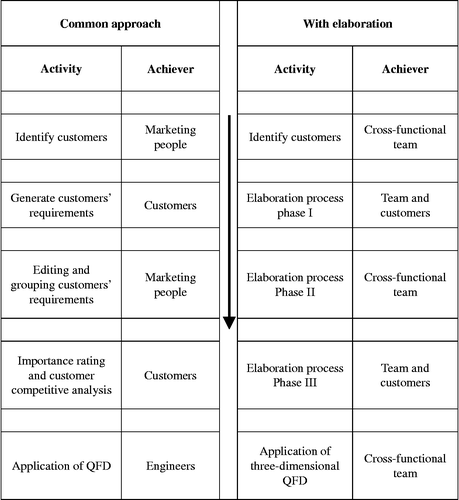
The cross-functional team identifies the customer groups. Brainstorming is used by the team members for this exercise. The team members discuss the matter with focus on the most important customers. Each customer receives an identification number. The groups with little interest in the product are included as well to avoid the omission of any requirements. As discussed by several authors (Mazur Citation1991; Mizuno and Akao Citation1994), a group of 25–30 customers is necessary to get 90–95% of the customer needs.
The elaboration process is carried out in three phases. Phase I allows the customers to identify their primary requirements and elaborate them into secondary requirements. The target of Phase II is for the team members to understand the gathered customer needs and to develop a rough configuration of a product concept. Phase III allows the customers to elaborate their secondary needs into tertiary requirements based on the rough product concept. The three phases are shown in Figure .
3.1 Phase I
The cross-functional team members and the customers together perform Phase I of the elaboration process. In Step 1, customers are given a short list of conventional default questions. The questions were aimed at asking the customers about the basic benefits and expectations they would like to get from a particular service or product. Customers are encouraged to discuss the questions with any team member. The questions cover different stages of customer/product relationship, e.g. before and after purchase, usage stage and customers' suggestions for product improvement. It is possible that the questions will lead the customers to explore some hidden or unspoken basic or exciting ideas. Figure shows some examples of possible conventional default questions.
In Step 2, the conventional default questions activate the customers' thoughts and ideas. It is expected that the customers identify between 5 and 10 primary requirements. These may or may not contain general environmental requirements, depending on the customers' environmental awareness.
In Step 3, the team members prepare a list of basic environmental default questions. The aim of the list is to raise the customers' environmental awareness. The team members explain the questions and describe the impact of a certain product on the environment. As a result, it is expected that some customers consider environmental aspects to become part of their personal satisfaction. Some examples of basic environmental questions are listed in Figure .
In Step 4, the customers explain and further describe their primary requirements. We assume that each primary need is elaborated into several secondary needs in the order of 3–10 for each primary need. It is expected that the basic environmental default questions trigger some customers' environmental concerns. As a result, some of the secondary requirements are environmental requirements.
3.2 Phase II
Phase II of the elaboration process is only performed by the team members. This phase is very similar to many traditional approaches used for product design. The team members analyse and discuss all primary and secondary customer requirements and then, in a short and simplified process, develop a rough configuration of a product concept. The purpose of the rough concept is to demonstrate to the customer in phase III what the possible result of their previously stated requirements might be. Therefore, the rough concept is mainly used as a communication tool, but not as a final design concept.
3.3 Phase III
This phase is a joint activity of the customers and the team members. In Step 1, every customer receives a copy of his/her primary and secondary requirements with additional comments made by the team members on their understanding and translation of the needs. Customers are also shown the rough product concept, which represents the interpretation of the customer requirements by the team members. This enables the customers to compare the product with their own understanding of the requirements and to identify possible misunderstandings.
One of the key objectives of the elaboration process is the generation of customer environmental awareness. For this reason, in Step 2, a detailed environmental statement (DES), is prepared by the team members and distributed to the customers. The DES describes in general and understandable terms the main issues of environmental effects of a product. The team can decide to add some more product-specific issues to the DES, if this helps the elaboration process. The customers are encouraged to ask for explanations of the items in the DES. Figure shows an example of a DES. The customers are advised to tick the factor in the DES relevant to their environmental concerns and submit the statement to the team members and/or to include their specific environmental requirements attributed to the product into their tertiary requirements.
The next Step 3 is a very important step of the elaboration process because it is the final input of the VOCs. The customers have to concentrate and explain the real meaning of their secondary requirements. The task of elaboration is difficult for some people. Some customers, by developing their tertiary needs, try to express their needs in terms of ‘How’ the need can be satisfied and not in terms of ‘What’ the need is. The tertiary requirements can be alternatives or non-alternatives, describing one secondary requirement. It is expected that some tertiary requirements have the form of engineering characteristics like ‘weight is less than 200 g’ or the ‘washing time is 30 min’. This limits the consideration of development alternatives, but it can be a useful and effective guide for designing team members to identify appropriate technical characteristics.
The customers are encouraged to ask questions and have discussions with the team members. Due to the DES, customers may review some of their tertiary requirements with negative environmental impact and consider alternative statements. At the end of this process in Step 4, a comprehensive list of clearly understood tertiary requirements is available, some of which are most likely environmental requirements. The total number of tertiary needs might vary between 45 and 300. The overall structure of the elaboration process is represented in Figure .
4 The key features of the elaboration process
When we compare the elaboration process with the traditional approaches, we can find the following key features and advantages of the new approach:
| • | a formal process with clear traceability of requirements; | ||||
| • | more specific and objective statements from customers; | ||||
| • | no misunderstanding of customer requirements; | ||||
| • | increased environmental awareness of customers and | ||||
| • | uncovering of unspoken requirements in areas such as: environmental features. Excitement features and psychological and cultural aspects. | ||||
5. Application examples from a case study
In the following, a few selected examples from an industrial case study are briefly explained in order to demonstrate the effects of the elaboration process on the outcomes of tertiary requirements. The increase in the environmental awareness of customers was found to be a general effect across the case study. It is not claimed that the case study represents a comprehensive survey of the studied service product. The analysis is focused on some typical customer requirement issues in order to design an environmentally conscious product with maximum customer satisfaction.
5.1 Case study: bus travel
This is a service product, and the aim of the elaboration process and QFD application was to improve the service for bus travellers. The VOC process was carried out with a large number of travellers at bus stops and depots in collaboration with a bus company.
5.1.1 Phase I
The first practical activity of this case study was the identification of customers who were passengers, covering all age categories, occupations and interests. This customer group included 30 people. In the first step of this phase, the list of conventional default questions was offered to the customers as follows:
| 1. | Why would (do) you choose bus travel instead of other transport means? | ||||
| 2. | How were your expectations satisfied before the trip (information, ticketing, scheduling…)? | ||||
| 3. | How can bus travel become more attractive and interesting to you? | ||||
| 4. | How would you encourage people to use bus travel? | ||||
The primary needs that were identified are presented in the first column in Figure .
At the beginning of the next step of this phase, the set of environmental default questions was distributed to the customers as follows:
| 1. | Do you know that some human activities harmfully affect the environment? | ||||
| 2. | Do you know that transport vehicles increase the pollution level and affect people's health? | ||||
| 3. | Do you have any environmental concerns about bus travel? | ||||
| 4. | Do you get personal satisfaction from adopting environmental concerns in your life style? | ||||
The customers' elaboration of their primary needs into secondary requirements is presented partially in the second column in Figure .
5.1.2 Phase II
This phase of the elaboration process was not run in detail in this case study. The reason is that the objectives of this case are independent of Phase II of the elaboration process.
5.1.3 Phase III
The aim of this phase is to get more precise information from the customers about their broad environmental and non-environmental secondary requirements. Each customer was provided with his/her primary and secondary requirements. The customers spent a short time for the revision of their requirements.
One objective of the elaboration process is the deployment of environmental knowledge through the customers. A DES similar to DES as presented in Figure was offered to the customers to describe the relationships between the bus travel and the environment. It was expected that the DES would generate the customers' environmental awareness. Some concepts mentioned in the DES, such as toxic materials, greenhouse gases, pollution, materials and energy consumption issues, related to a bus travel life cycle were explained to the customers targeting the deployment of a sustainability concept.
The customers were asked to tick those factors in the DES, which were relevant to their environmental concerns, and/or to include their specific environmental requirements for bus travel into their tertiary requirements. The customers were found to be very responsible and highly committed to their tasks. Typically, the customers elaborated their environmental and non-environmental secondary requirements; they gave clearer and more precise explanations about the real desires behind their words. They thought seriously and clearly in an objective way. The task was difficult for some of the customers because they could not elaborate their ‘What’. The customers discussed many needs with the interviewer, who helped by posing additional questions. At the end of this activity, the customers arranged their needs in a hierarchical structure (primary–secondary–tertiary).
At the end of this phase, 113 tertiary requirements were identified through elaboration of the customers' secondary needs. An extract of the list of customer requirements is shown in Figure , including all primary requirements but only a few selected secondary and tertiary requirements. The tertiary requirements in the figure, written in italic, are examples of unspoken requirements, related to environmental or cultural concerns, which were only uncovered through the elaboration process.
6. The benefits of the elaboration process
| 1. | The elaboration process required only 15 h for gathering and analysing the customer requirements. According to the literature review, this is a fairly short time for gathering and analysing the customer requirements. | ||||||||||||||||||||||||||||||||||||||||||||||||||||||||||||||||||||||
| 2. | The elaboration process uncovered some unexpected customers' requirements such as ‘Ticket inserted into a device attached to each seat.’ | ||||||||||||||||||||||||||||||||||||||||||||||||||||||||||||||||||||||
| 3. | The elaboration process changed the customers' requirements to be more objective rather than subjective. The tertiary customer requirements express precise information, for example, ‘Inspection machine at bus entrance.’ | ||||||||||||||||||||||||||||||||||||||||||||||||||||||||||||||||||||||
| 4. | The elaboration process generated environmental awareness of the customers. It was discovered that only 40% of the customers had primary environmental requirements. However, the analysis of the secondary requirements revealed the effect of the basic environmental defaults questions for deploying environmental knowledge through the customers. It was identified that
Moreover, the analysis of the tertiary requirements showed the effective role of the ‘DES’ for deploying environmental knowledge through the customers, resulting in the fact that: All customers had tertiary environmental requirements and got personal satisfaction from adopting environmental concerns in their lifestyles. The author also explained to the customers some of the tertiary needs, which had negative environmental impacts, for example ‘machine inside the bus for ticket disposal’. This requirement was finally removed from the list of tertiary needs. An alternative solution is to install this machine in the main bus stations only. In addition, some customers' tertiary requirements sent a few messages to bus manufacturers, such as the usage of solar energy for television and video facilities and recycled water for flushing, etc. In conclusion, the elaboration process is spreading environmental knowledge to the public and sending messages to manufacturers for environmentally conscious manufacturing.
| ||||||||||||||||||||||||||||||||||||||||||||||||||||||||||||||||||||||
7. Conclusion
In this paper, the benefits of the elaboration process were demonstrated, including the gathering of more than 100 clearly understandable customer requirements and the deployment of environmental knowledge through the customers by the provision of basic environmental default questions and a DES for bus travel. In addition, the elaboration process uncovered some unexpected customer requirements and psychological factors, related to customer needs and desires, such as passenger privacy.
Also, the results show that the elaboration process has many benefits, such as sending customer messages to manufacturers, or consideration of the environmental voice of the community. It is also revealed that the elaboration process applied in this case study performs well in terms of designing an environmentally conscious product within the required time and cost.
8. Future research work
The realisation of QFD largely depends on gathering and understanding spoken customer requirements. This presents a problem for capturing environmental issues of product design, which fall into the category of unspoken customer requirements. The elaboration process presented in this research paper provides a methodology for designers to gather a quality input for the application of QFD. The process of gathering customer requirements is now a part of the product design process.
Future research and extensions to the current research work are as follows.
The number of customer tertiary needs is too high to be used in the next steps of QFD process. Therefore, the amount of customer needs has to be reduced without compromising the satisfaction of the customer. Environmental Metrics, which are the parameters used to measure design improvement with respect to environmental goals, should be developed and used in the application of QFD as evaluation criteria for customer requirements before any design concepts are being developed.
References
- Applied Marketing Science Inc. 2000 . Why we do what we do. Questions and answers about VOCALYST , Waltham, MA : Company Press .
- Daetz , D. , William , B. and Richard , N. 1995 . Customer integration: the quality function deployment leader's guide for decision making , New York : Wiley .
- Klein , R.L. 1990 . New techniques for listening to the voice of the customer . Journal of Service Research , 1 ( 2 ) : 178 – 186 .
- Kott , A. and Peasant , J.L. 1995 . Representation and management of requirements: the RAPID-WS project . The Journal of Concurrent Engineering: Research and Applications , 3 ( 2 ) : 93 – 106 .
- Liner , M. 1994 . “ A road map for gathering data from customers: lessons from experience ” . In transactions from the sixth symposium on quality function deployment , MI. Ann Arbor, MI : QFD Institute . 12–14 June, Novi
- Mazur , G. 1991 . “ Voice of the customer analysis and other recent QFD technology ” . In transactions from the third symposium on quality function deployment , MI. Ann Arbor, MI : QFD Institute . 24–25 June, Novi
- Mazur , G. 1997 . “ Voice of customer analysis: a modern system of front-end QFD tools ” . In Proceedings of the 51st Congress of the American Society for Quality 5–7 May, Orlando, FL
- Mizuno , S. and Akao , Y. 1994 . QFD: The customer-driven approach to quality planning and deployment , Translated by Glenn Mazur, Tokyo Englewood Cliffs, NJ : Prentice Hall .
- Stickel , F. and Bosserman , S. 1996 . “ Motorola's six pack QFD total customer satisfaction team ” . In Transactions of the 8th symposium on QFD , MI. Ann Arbor, MI : QFD Institute . 9–11 June, Novi
- Swanson , D.A. and Hauser , J.R. 1995 . “ The voice of the customer: how can you be sure you know what customers really want ” . Englewood Cliffs, NJ : Prentice Hall . Proceedings of the 1st Pacific Rim symposium of quality function deployment, 15–17 February, Sydney, Australia
- Urban , G.L. and Hauser , J.R. 1993 . Design and marketing of new products , 2nd Ed. , Englewood Cliffs, NJ : Prentice Hall .


